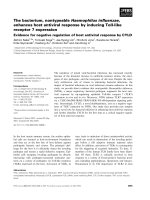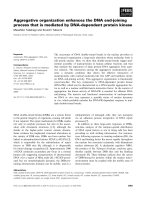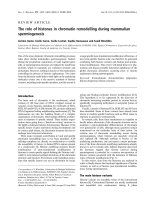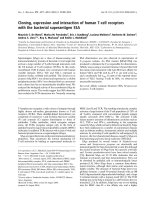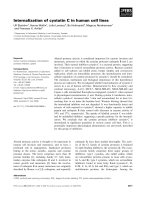Báo cáo khoa học: "MicroRNA-17-92 significantly enhances radioresistance in human mantle cell lymphoma cells" pot
Bạn đang xem bản rút gọn của tài liệu. Xem và tải ngay bản đầy đủ của tài liệu tại đây (1.25 MB, 8 trang )
RESEA R C H Open Access
MicroRNA-17-92 significantly enhances
radioresistance in human mantle cell
lymphoma cells
Ping Jiang
1
, En Y Rao
2
, Na Meng
1
, Yong Zhao
2
, Jun J Wang
1*
Abstract
The microRNA-17-92 (miRNA-17-92) cluster, at chromosome 13q31-q32, also known as oncomir-1, consists of seven
miRNAs that are transcribed as a polycistronic unit. Over-expression of miRNA-17-92 has been observed in
lymphomas and other solid tumors. Whether miRNA-17-92 expression affects the response of tumor cells to
radiotherapy is not addressed so far. In the present study, we studied the effects of miRNA-17-92 on the
radiosensitivity of human mantle cell lymphoma (MCL) cells Z138c. Over-expression of miRNA-17-92 significantly
increased survival cell number, cell proliferation and decreased cell death of human MCL cells after different doses
of radiation. Immunoblot analysis showed that phosphatase and tension homolog (PTEN) and PHLPP2 was down-
modulated and pAkt activity was enhanced in MCL cells after over-expressing miRNA-17-92 after irradiation. These
findings are the first direct evidence that over-expression of miRNA-17-92 cluster significantly increases the
radioresistance of human MCL cells, which offers a novel target molecule for improving the radiotherapy of MCL in
clinic.
Introduction
The importance of microRNAs in can cer is highlighted
by the observation that approximately 50% of miRNA
genes are located in cancer-associated genomic regions
or in fragile sites [1,2], which are frequently amplified or
deleted in tumorigenesis. Mantle cell lymphoma (MCL)
is an aggressive hematological malignancy, characterized
by the chromosomal translocation t(11;14)(q13;q32),
which results in deregulated aberrant expression of cyclin
D1, and comprises 5%-10% of human B-cell malignancies
[3]. The median survival o f patients with MCL ranges
between 3 and 5 years according to most studies [4,5].
Studies in transgenic mice imply that the t(11;14)(q13;
q32) translocation alone is not sufficie nt to result in lym-
phoma, and additional genetic alterations are necessary
[6,7]. Secondary genomic alterations are frequently
detected in MCL, of which chromosome 13q31-q32 gain/
amplification is one of the most frequent [8,9]. Studies
have shown that amplification at chromosome 13q31-
q32 targets a microRNA cluster, microRNA-17-92
(miRNA-17-92), which resides within intron 3 of
c13orf25, a non-protein-coding gene at 13q31.3 [10,11].
The miRNA-17-92 cluster, which modulates E2F1
expression, is positively regulated by MyC [12], can
potentially become a very potent oncogene, targeting
multiple cellula r pathways and favoring tumorigenesis by
enhancing cell proliferation and inhibiting apoptosis. Pre-
vious data have shown that miRNA-17-92 can increase
MyC-enhanced proliferation by targeting p21 and cons e-
quently activating the cyclinD1/CDK4 complex to release
retinoblastoma inhibition of E2F genes [13,14]. miRNA-
17-92 is also capable of minimizing MyC-induced apop-
tosis by targ eting the Bcl2-like Bim an d phosphatase and
ten sion homolog (PTEN) genes [15] to i ncre ase the level
of anti-apoptotic BCL2.
Radiation therapy is one of the thr ee primary modal-
ities used in cancer treatment. Whether miRNA-17-92
expression affects the response of tumor cells to radio-
therapy has not been investigated so far. To elucidate this
issue, we generated stable MCL cell lines with high
expression of the miRNA-17-92 cluster and the radiosen-
sitivity was determined. We found that over-expression
of miRNA-17 -92 in MCL cells remarkably decreases the
radiosensitivity of the MCL cell line Z138c while the
* Correspondence:
1
Department of Radiation Oncology, Peking University Third Hospital, Beijing
100191, China
Full list of author information is available at the end of the article
Jiang et al. Radiation Oncology 2010, 5:100
/>© 2010 Jiang et al; licensee BioMed Central Ltd. This is an Open Access article distributed under the terms of the Creative Comm ons
Attribution License ( which permits unrestricted use, distribution, and reproduction in
any mediu m, provided the original work is properly cited.
activity of PI3K/Akt pathway is enhanced possibly via
down-regulation of PTEN and PHLPP2. We thus offered
first evidence that miRNA17-92 is closely involved in the
radioresistance of tumor cells.
Materials and met hods
Plasmid, cell lines and cell transfection
The tetracyclin-regulated retroviral vector TMP (Open-
BioSystem, Huntsville, AL) was modified by deleting the
miR-30 sequence using PCR with the following primers:
5’ -PO4-GCCTCGAGCCTGAGGCTGGATCGGTCC
CGGTGTCTTCTATGG-3’,and5’-PO4-TGAGGGAAT
TCGGACCGGGTAGGGGAGGCGCTTTTCCCAAG-3’.
The PCR product was then circularized by blunt-end
ligat ion to generate the miRNA-17-92 cluster was ampli-
fied from human genomic DNA using the following pri-
mers: 5’-tttttctcgaGTGTCTAAATGGACCTCATATC
TTTGAG-3’ ,and5’-gtttttgaattCCAAATCTGACACG-
CAACCC-3’ (antisense) and Phusion Taq Polymerase
(New England Biolabs, Bost on, MA). The PCR product
was then cloned into the TMP2 vector to generate the
plasmid TMP2-miR-17-92. Vector TMP2 and plasmid
TMP2-miR-17-92 were kindly provided by Dr En Y Rao
who was in Institute of Zoology, Chinese Academy of
Sciences. To construct 3’untranslated regio n (UTR) luci-
ferase reporter plasmids, the pGL3 vector with luci ferase
coding sequence purchased from Promega company, USA.
The expression level of m ature miRNAs was deter-
mined using the TaqMan miRNA Assay (Applied Biosys-
tems, Foster City, CA) with sli ght modification. Briefly,
single-strandedcDNAwassynthesizedfrom10ngof
total RNA using the TaqMan MicroRNA Reverse Tran-
scription Kit. Each cDNA generated was a mplified by
quantitative PCR using sequence-specific primers from
the TaqMan Mi croRNA Assays (Human Panel) on a
7900HT Sequence Detection System. The relative quan-
tity of the target miRNAs was estimated by the 2
- ΔΔCT
method by normalizing to the expression level of b-actin,
which was detected by a TaqMan gene expression Assay.
Human mantle cell lymphoma (MCL) cell line Z138c
was provided by institute of zoology, Chinese Academy
of Sciences.
Tetracycline-regulated pRevTet-On expression system
purchased from Clontech, USA, operated according to
the m anufacture r’ s instructions. The human embryonic
kidney cell line HEK293T was co-transfected with the
pRevTet-On vector and pCL packaging plasmid using
the calcium phosphate method. The virus supernatant
was collected and used to infe ct Z13 8c. The transfected
cell line Z138c-Tet-On was selected with G418 (1 μg/
ml) which purchased from Sigma company USA. To
further establish TMP2-miR17-92 cell line, the
HEK293T cell line was co-transf ected with the TMP2-
miR-17-92 vector and pCL packaging plasmid by the
calcium phosphate method, and the virus supernatant
was collected and used to transfect the established
Z138c-Tet-on cells. These cells were further selected
with puromycin resistance and green fluorescent protein
(GFP) expressing cells were isolated by fluorescence
activated cell sorter, (FACS). The cell lines which over-
express miR-17-92 were maintained in the presence of
doxycycline (1 μg/ml).
The HEK293T cell line was co-transfecte d with th e
TMP2 vector and pCL packaging plasmid by the cal-
cium phosphate method, and the virus supernatant was
collected and used to infect the established Z138c-Tet-
on cells. And then Z138c-TMP2 cell line was generated.
Cell culture
The Z138c-miRNA-17-92 cell lines and Z138c-TMP2 cell
lines were suspended in RPMI1640 supplemented with
10% fetal bovine serum (FBS), 100 UI/ml penicillin, and
100 UI/ml streptomycin. Doxycycline (1 μg/ml) was added
to induce the expression of miRNA-17-92. The cells were
incubated in a humidified atmosphere of 5% CO
2
at 37°.
Irradiation conditions
Linear accelerators producing 6 MV X-ray beams were
provided b y the 306 Hospital of the People’s Liberation
Army (Beijing, China). The dose rate was 400 c Gy/min
and the source-to-skin distance (SSD) was 100 cm. The
surface of the culture dishes was covered by 2 cm of
packing materials. Radiation doses were: 0, 0.5, 1, 2, 3, 4
and 6 Gy.
Viable cell count
Z138c-TMP2 and Z138c-TMP2-miRNA-17-92 cells in
exponentia l growth were irradiated by 6 MV X-ray at
variousdoses(0,0.5,1,2,3,4,and5Gy).Threewells
in each dose in 24 well plates were cultured for 24, 48,
72 or 96 h in a n incubator, cells were stained with try-
pan blue for the viable count estimation.
Cell proliferation measured by
3
H-TdR incorporation
Z138c-TMP2 and Z138c-miRNA-17-92 cells in expo-
nential growth were irradiated by 6 MV X-ray at various
doses (0, 0.5, 1, 2, 3, 4, 5, and 6 Gy). Cells were plated
in 96-well plates in 200 μlofgrowthmediumand
allowed to attach for 12, 36, 60, 84 or 112 h, and 0.5
μCi
3
H-Td R per well was added respectively, then incu-
bated for 12 h at 37°. After incubation the cells were
collected and distributed through a glass fiber f ilter by
using a multiple head cell harvester type DYQ-Ⅱ.When
the filter membrane was dry, the corresponding mem-
branes were cut off and put into 5 ml of scintillation
solution to be detected.
Jiang et al. Radiation Oncology 2010, 5:100
/>Page 2 of 8
Cell cycle analysis by flow cytometry (FCM)
Z138c-TMP2 and Z138c-miRNA-17-92 cells in expo-
nential growth were irradiated by 6 MV X-ray at various
doses (0, 2, and 4 Gy). 24 h after irradiation, cell cycle
was analyzed using FCM as described previously.
Z138c-TMP2 and Z138c-TMP2-miRNA-17-92 cells in
exponential growth were irradiated by 6 MV X ray at var-
ious doses (0, 2, and 4 Gy). 24 h after irradiation, 2 × 10
6
cells were taken from each sample to be tested, which
were fixed by 3 ml 70% alcohol at -20° over night. Then
washed by PBS twice and suspended in 200 ul PBS,
placed in 37° water for 30 min, mixed with 10 mg/ml
RNA enzyme and 500 μg/ml PI, waiting to be tested.
Apoptosis and necrosis analysis by FCM
Z138c-TMP2 and Z138c-TMP2-miRNA-17-92 cells in
exponential growth were irradiated by 6 MV X ray at
various doses (0, 2, and 4 Gy, respectively). 72 hour s
later, cells were plated in 24-well plates and 1 ml 1%
Hochest33324 per well was added respectively, taken
photo after 30~40 min.
Z138c-TMP2 and Z138c- TMP2-miRNA-17- 92 cells in
exponential growth were irradiated by 6 MV X ray at
various doses (0, 2, and 4 Gy, respectively). 72, 96, 120
hours a fter irradiation, the cells were stained by Propi-
dium iodide (PI) to detect the percent of cell death.
Immunoblotting and antibodies
Cell lysates containing 20 μg of protein were resolved
on sodium dodecyl-sulf ate polyacrylamide g el electro-
phoresis (SDS-PAGE) and transferred to nitrocellulose
membranes (Hybond-P, Amersham, Buckinghamshir e,
UK). The membranes were incubated with 5% non-fat
milk blocking buffer (TBS-T) for 1 h at room tempera-
ture and then incubated overnight at 4°C with the pri-
mary antibodies. Membranes were washed with PBS
containing 0.1% Tween-20 (PBS-T), then incubated in
the dark for 1 h at room temperature with IRDye 680-
conjugated goat anti-rabbit IgG or IRDye 800 conju-
gated goat anti-mouse IgG in Odyssey blocking buffer.
After washing with PBS-T, proteins were detected and
quantified using the Odyssey Infrared Imaging System
(LI-COR B iosciences). For each study, data were re pre-
sentative of three independent experiments.
Antibodies for immunoblotting in this study were as
follows: anti-PTEN, anti-Akt, anti -p-Akt-ser473 (Cell
Signaling Biotechnology, Beverly, MA, USA), anti-goat
IgG-HRP, anti-actin, and anti-PH d omain leucine-rich
repeat protein phosphatase (PHLPP) (Novus Biologicals,
Littleton, CO, USA).
Statistical analysis
All data have been presented as the mean ± s.d. Stu-
dent’s unpaired t-test for comparison of means has been
used to compare groups. A P-value 0.05 has been con-
sidered to be statistically significant.
Results
The over-expression of miRNA-17-92 significantly
enhanced survival of Z138c cells after different doses of
radiation
In order to determine whether over-expression of
miRNA-17-92 could change the survival of Z138c cells
after ionizing irradiation, we counted the v iable cells
after different doses of irradiation and at different time
points. A s shown in Figure 1, there were no differences
between the two groups in viable Z138c-TMP2 or
Z138c-miRNA-17-92 cell counts without radiation.
However, viable cell counts w ere significantly higher in
the miRNA-17-92 group than in the TMP2 group when
these cells received different doses of irradiation by
1 day after irradiation (P < 0.05, P < 0.01, and P <
0.001, respectively, Figure 1).
The different proliferative ability of Z138c-TMP2 and
Z138c-miRNA-17-92 cells after different doses of radiation
To investigate the effect of miRNA-17-92 on the prolif-
erating ability of tumor cells, we detected the cell prolif-
eration of Z138c cells expressing miRNA17-92 or
control vector after irradiation using a
3
H-TdR incor-
porationassay.Therewerenodifferencebetweenthe
two groups after radiatio n at 0 Gy (Figure 2). However,
statistically significant differences were obtained at a
radiation dose of 2 Gy and incubation times of 48, 72,
96, and 120 h and at a radiation dose of 4 Gy and incu-
bation times o f 24, 48 h, 72, 96, and 120 h (P < 0.05,
P < 0.01 or P < 0.001, Figure 2).
The cell cycle distribution of Z138c-TMP2 and Z138c-
miRNA-17-92s cells after different doses of radiation
The cell cycle was det ermined by PI staining and assayed
by FCM. The percentage of G2/M cells in the Z138c-
TMP2 cells increased after radiation doses of 2 Gy and 4
Gy comparing with the non-irradiated cells (Figure 3).
However, no obvious radiation-induced G2/M cell cycle
arrest was observed in Z138c-miRNA-17-92 cells. A sta-
tistically significant difference (t = 2.885, P < 0.05) was
obtained at a radiation dose of 4 Gy compared between
Z138c-TMP2 and Z138c-miRNA-17-92 cells.
The cell death of Z138c-TMP2 and Z138c-miRNA-17-92s
cells after different doses of radiation
The cell death ratio was evaluated using traditional PI
staining assay. As shown in Figure 4, more d ead cells
were seen in the Z138-TMP2 cells than in Z138c-
miRNA-17-92 c ells at 72, 96, and 120 h after radiation,
regardless of radiation doses, respectively. Statistically
significant differences were observed at a radiation dose
Jiang et al. Radiation Oncology 2010, 5:100
/>Page 3 of 8
of 2 Gy and incubation times of 96, or 120 h and at a
radiation dose of 4 Gy and incubation times of 96 or
120 h (P < 0.05, P < 0.01 or P < 0.001, re spectively,
Figure 4).
The expression of the proteins pAkt, PTEN and PHLPP2 in
Z138c-TMP2 and Z138c-miRNA-17-92 cells after radiation
As PTEN and PHLPP2 are the target genes of miRNA-
17-92, we thus examined the protein expression of
pAkt, PTEN and PHLPP2 in both cell lines by immuno-
blot analysis after radiation. As shown in Figure 5, com-
pared with Z138c contro l cells, PTEN and PHLPP2
protein levels were reduced in Z138c-miRNA-17-92
cells after radiation. Consistently, pAkt was enhanced in
Z138c-miRNA-17-92 cells after radiation.
Discussion
MCL is c onsidered incurable with the current che-
motherapeutic regimen. Gene expression profiling (GEP)
studies have shown that the survival of MCL patients is
closely correlated with the proliferation signature of the
tumor cells [16]. It is interesting that over-expression of
c13orf25, the primary transcript from which miRNA-17-
92 is processed, has been associated with increased
expression of genes associated with proliferation and
poorer survival. Since this observation is based on GEP
analysis, further large-scale, confirmatory, clinical studies
using more specific approaches are warranted. In the pre-
sent study, we demonstrated that over-expression of
miRNA17-92 in tumor cells can significantly enhance the
resistance to radiation-induced cell damage including cell
Figure 1 The over-expression of miRNA-17-92 significantly enhanced survival of Z138c cells after different doses of radiation. Z138c-
TMP2 or Z138c-miRNA-17-92 cells were cultured for different days after receiving 0 (A), 2 ( B), 3 (C), or 4 (D) Gy X-ray irradiation. Data have been
presented as mean ± s.d. (N = 5). One representative of three experiments has been shown. *P < 0.05, **P < 0.01 or ***P < 0.001 as compared
among the identical groups.
Jiang et al. Radiation Oncology 2010, 5:100
/>Page 4 of 8
death and G2/M phase arrest. Our findings suggest that
targeting the miRNA-17-92 cluster may provide a novel
therapeutic approach for MCL patients. It may be impor-
tant for us to see whether the expression of this cluster is
closely relevant to the radiation sensitivity or not in the
clinical cases in the future.
PTEN is a lipid phosphatase that removes the activat-
ing signal and ultimately prevents Akt phosphorylation
and activation, while PHLPP2 terminates Akt signaling
by directly dephosphorylating and inactivating Akt,
thus, both pTEN and PHLLP2 negatively regulates
PI3K/Akt signaling pathway, which is one of the most
important pathways for cell survival and inhibition of
apoptosis [17-20]. Deletion of the chromosome 10
PTEN gene plays a role in tumor suppression. After
X-ray radiation, Z138c cells wi th over-expression of
miRNA-17-92 showed down-modulated tumor sup-
pressors PTEN and PHLPP2 and enhanced pAkT as
determined by western blot. Ramaswamy et al [21]
showed that suppression of the PTEN/PI3K/AKT sig-
naling pathway may increase the radiosensitivity of
malignant brain neurogliocytoma cells. Our present
study showed that over-expression of miRNA-17-92
decreased both PTEN and PHLPP expression and
thereby enhanced PI3K pathway and finally results in
cell death resistance induced by x-rays. Because of the
complexity of miRNA-17-92 function, more targets
may exist for regulating the cell transduction signal by
miRNA-17-92 th rough various modes, which will be a
future goal of our research.
Figure 2 The different proliferative ability of Z138c-TMP2 and Z138c-m iRNA-17-92 cell lines after different doses of radiation. The cell
proliferation of Z138c cells expressing miRNA-17-92 or control vector was detected using a
3
H-TdR incorporation assay after different doses of
irradiation. A) the cell proliferation of Z138c-TMP2 or Z138c-miRNA-17-92 cells after different doses of radiation. B) the cell proliferation of cells
without radiation. C) the cell proliferation of Z138c-TMP2 or Z138c-miRNA-17-92 cells at different days after 2 Gy radiation. D) the cell
proliferation of cells at different days after 4 Gy radiation. Data have been presented as mean ± s.d. (N = 5). One representative of three
experiments has been shown. *P < 0.05, **P < 0.01 or ***P < 0.001 as compared among the identical groups.
Jiang et al. Radiation Oncology 2010, 5:100
/>Page 5 of 8
In a summary, miRNA-1 7-92 is closely involved in the
regulation of radiosensitivity of tumor cells. It directly
down-regulates the expression of t he PTEN and
PHLPP2 proteins, subsequently activates the PI3K/Akt
signal pathway, and thus results in the resistance to
radiation of the MCL Z138c cell line. MiRNA-17-92
may be a potential molecular tar get for impro ving the
radiotherapy.
Acknowledgements
The authors wish to thank Ms. Jing Wang and Ms. Jian X Peng for their
expert technical assistance, Ms. Qing H Li for her excellent laboratory
management. This work was supported by a grant from the Ministry of Civil
Affair, China ([2007]8).
Author details
1
Department of Radiation Oncology, Peking University Third Hospital, Beijing
100191, China.
2
Transplantation Biology Research Division, State Key
Laboratory of Biomembrane and Membrane Biotechnology, Institute of
Zoology, Chinese Academy of Sciences, Beijing 100101, China.
Authors’ contributions
PJ carried out cell colony-forming assay, fluorescence-activated cell sorting,
flow cytometric analysis, and drafted the manuscript. JJW participated in its
design and revised the manuscript. NM performed the statistical analysis and
carried out the irradiation experiment. YZ and EYR supervised experimental
work and revised the manuscript. All authors read and approved the final
manuscript.
Figure 3 The cell cycle distribution of Z138c-TMP 2 and Z138c-miRNA-17-92 cells after different doses of radiation. The cell cycle of
Z138c-TMP2 and Z138c-miRNA-17-92 cells was determined by PI staining and detected by FCM at 1 day after radiation. A) one representative of
cell cycle distribution as detected by FCM. B) a summary of different cell phases of Z138c-TMP2 and Z138c-miRNA-17-92 cell lines. Data have
been presented as mean ± s.d. (N = 5). One representative of three experiments has been shown. *P < 0.05 as compared among the identical
groups.
Jiang et al. Radiation Oncology 2010, 5:100
/>Page 6 of 8
Figure 4 The cell death of Z138c-TMP2 and Z138c-miRNA-17-92s after dif ferent doses of radiation. The cell death ratios of Z138c-TMP2
cells and Z138c-miRNA-17-92 cells were evaluated using traditional PI staining assay. A) one representative of cell death as detected by 1%
Hochest33324 staining at 3 days after radiation. B) one representative of cell death as detected by FCM at 3 days after radiation. C) a summary
of cell death ratios in Z138c-TMP2 and Z138c-miRNA-17-92 cells. Data have been presented as mean ± s.d. (N = 5). One representative of three
experiments has been shown. *P < 0.05, **P < 0.01 or ***P < 0.001 as compared among the identical groups.
Figure 5 The expression of the proteins p-Akt, PTEN and PHLPP2 in Z138c-TMP2 and Z138c-miRNA-17-92 cells after radiation.The
protein expression of pAkt, PTEN and PHLPP2 in both cell lines was detected by immunoblot analysis at 1 day after radiation as described in
materials and methods. One representative of three experiments has been shown.
Jiang et al. Radiation Oncology 2010, 5:100
/>Page 7 of 8
Competing interests
The authors declare that they have no competing interests.
Received: 21 August 2010 Accepted: 1 November 2010
Published: 1 November 2010
References
1. Calin GA, Sevignani C, Dumitru CD, Hyslop T, Noch E, Yendamuri S,
Shimizu M, Rattan S, Bullrich F, Negrini M, Croce CM: Human microRNA
genes are frequently located at fragile sites and genomic regions
involved in cancers. Proc Natl Acad Sci USA 2004, 101:2999-3004.
2. Sevignani C, Calin GA, Siracusa LD, Croce CM: Mammalian microRNAs: a
small world for fine-tuning gene expression. Mamm Genome 2006,
17:189-202.
3. Jaffe ES: Anaplastic large cell lymphoma: the shifting sands of diagnostic
hematopathology. Mod Pathol 2001, 14:219-228.
4. Bosch F, Lopez-Guillermo A, Campo E, Ribera JM, Conde E, Piris MA,
Vallespi T, Woessner S, Montserrat E: Mantle cell lymphoma: presenting
features, response to therapy, and prognostic factors. Cancer 1998,
82:567-575.
5. Argatoff LH, Connors JM, Klasa RJ, Horsman DE, Gascoyne RD: Mantle cell
lymphoma: a clinicopathologic study of 80 cases. Blood 1997,
89:2067-2078.
6. Bodrug SE, Warner BJ, Bath ML, Lindeman GJ, Harris AW, Adams JM: Cyclin
D1 transgene impedes lymphocyte maturation and collaborates in
lymphomagenesis with the myc gene. EMBO J 1994, 13:2124-2130.
7. Lovec H, Grzeschiczek A, Kowalski MB, Moroy T: Cyclin D1/bcl-1 cooperates
with myc genes in the generation of B-cell lymphoma in transgenic
mice. EMBO J 1994, 13:3487-3495.
8. Wlodarska I, Pittaluga S, Hagemeijer A, De Wolf-Peeters C, Van Den
Berghe H: Secondary chromosome changes in mantle cell lymphoma.
Haematologica 1999, 84:594-599.
9. Salaverria I, Zettl A, Bea S, Moreno V, Valls J, Hartmann E, Ott G, Wright G,
Lopez-Guillermo A, Chan WC, Weisenburger DD, Gascoyne RD, Grogan TM,
Delabie J, Jaffe ES, Montserrat E, Muller-Hermelink HK, Staudt LM,
Rosenwald A, Campo E: Specific secondary genetic alterations in mantle
cell lymphoma provide prognostic information independent of the gene
expression-based proliferation signature. J Clin Oncol 2007, 25:1216-1222.
10. Ota A, Tagawa H, Karnan S, Tsuzuki S, Karpas A, Kira S, Yoshida Y, Seto M:
Identification and characterization of a novel gene, C13orf25, as a target
for 13q31-q32 amplification in malignant lymphoma. Cancer Res 2004,
64:3087-3095.
11. He L, Thomson JM, Hemann MT, Hernando-Monge E, Mu D, Goodson S,
Powers S, Cordon-Cardo C, Lowe SW, Hannon GJ, Hammond SM: A
microRNA polycistron as a potential human oncogene. Nature 2005,
435:828-833.
12. O’Donnell KA, Wentzel EA, Zeller KI, Dang CV, Mendell JT: c-Myc-regulated
microRNAs modulate E2F1 expression. Nature 2005, 435:839-843.
13. Fontana L, Fiori ME, Albini S, Cifaldi L, Giovinazzi S, Forloni M, Boldrini R,
Donfrancesco A, Federici V, Giacomini P, Peschle C, Fruci D: Antagomir-17-
5p abolishes the growth of therapy-resistant neuroblastoma through
p21 and BIM. PLoS One 2008, 3:e2236.
14. Wang Q, Li YC, Wang J, Kong J, Qi Y, Quigg RJ, Li X:
miR-17-92 cluster
accelerates adipocyte differentiation by negatively regulating tumor-
suppressor Rb2/p130. Proc Natl Acad Sci USA 2008, 105:2889-2894.
15. Xiao C, Srinivasan L, Calado DP, Patterson HC, Zhang B, Wang J,
Henderson JM, Kutok JL, Rajewsky K: Lymphoproliferative disease and
autoimmunity in mice with increased miR-17-92 expression in
lymphocytes. Nat Immunol 2008, 9:405-414.
16. Rosenwald A, Wright G, Wiestner A, Chan WC, Connors JM, Campo E,
Gascoyne RD, Grogan TM, Muller-Hermelink HK, Smeland EB, Chiorazzi M,
Giltnane JM, Hurt EM, Zhao H, Averett L, Henrickson S, Yang L, Powell J,
Wilson WH, Jaffe ES, Simon R, Klausner RD, Montserrat E, Bosch F,
Greiner TC, Weisenburger DD, Sanger WG, Dave BJ, Lynch JC, Vose J, et al:
The proliferation gene expression signature is a quantitative integrator
of oncogenic events that predicts survival in mantle cell lymphoma.
Cancer Cell 2003, 3:185-197.
17. Chu EC, Tarnawski AS: PTEN regulatory functions in tumor suppression
and cell biology. Med Sci Monit 2004, 10:RA235-241.
18. Kandasamy K, Srivastava RK: Role of the phosphatidylinositol 3’-kinase/
PTEN/Akt kinase pathway in tumor necrosis factor-related apoptosis-
inducing ligand-induced apoptosis in non-small cell lung cancer cells.
Cancer Res 2002, 62:4929-4937.
19. Liu JL, Sheng X, Hortobagyi ZK, Mao Z, Gallick GE, Yung WK: Nuclear PTEN-
mediated growth suppression is independent of Akt down-regulation.
Mol Cell Biol 2005, 25:6211-6224.
20. Brognard J, Sierecki E, Gao T, Newton AC: PHLPP and a second isoform,
PHLPP2, differentially attenuate the amplitude of Akt signaling by
regulating distinct Akt isoforms. Mol Cell 2007, 25:917-931.
21. Ramaswamy S, Nakamura N, Vazquez F, Batt DB, Perera S, Roberts TM,
Sellers WR: Regulation of G1 progression by the PTEN tumor suppressor
protein is linked to inhibition of the phosphatidylinositol 3-kinase/Akt
pathway. Proc Natl Acad Sci USA 1999, 96:2110-2115.
doi:10.1186/1748-717X-5-100
Cite this article as: Jiang et al.: MicroRNA-17-92 significantly enhances
radioresistance in human mantle cell lymphoma cells. Radiation
Oncology 2010 5:100.
Submit your next manuscript to BioMed Central
and take full advantage of:
• Convenient online submission
• Thorough peer review
• No space constraints or color figure charges
• Immediate publication on acceptance
• Inclusion in PubMed, CAS, Scopus and Google Scholar
• Research which is freely available for redistribution
Submit your manuscript at
www.biomedcentral.com/submit
Jiang et al. Radiation Oncology 2010, 5:100
/>Page 8 of 8




